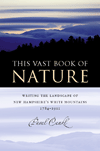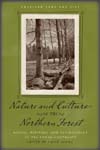This Vast Book of Nature
“The White Mountains, along with the Hudson River and the Adirondacks, were one of the first places that Americans learned to love the sublime, the awe-inspiring, the wild. These peaks have served many other intellectual purposes over the years as well—and anyone who has ever hiked the Great Gulf or Tuckerman’s Ravine will want to read Pavel Cenkl’s fine account of all the meanings they’ve carried.”—Bill McKibben, author, Wandering Home
“Where others might see only a mountain range, Pavel Cenkl sees cultural history. He has produced his own kind of White Mountain guidebook, exploring the many layers of meaning that people have applied to those peaks over time. This book will be valuable to anyone interested in the way Americans produce cultural significance from their natural surroundings.”—Kent C. Ryden, author, Landscape with Figures: Nature and Culture in New England
This Vast Book of Nature is a careful, engaging, accessible, and wide-ranging account of the ways in which the White Mountains of northern New Hampshire—and, by implication, other wild places—have been written into being by different visitors, residents, and developers from the post-Revolutionary era to the days of high tourism at the beginning of the twentieth century. Drawing on tourist brochures, travel accounts, pictorial representations, fiction and poetry, local histories, journals, and newspapers, Pavel Cenkl gauges how Americans have arranged space for political and economic purposes and identified it as having value beyond the economic.
Starting with an exploration of Jeremy Belknap’s 1784 expedition to Mount Washington, which Cenkl links to the origins of tourism in the White Mountains, to the transformation of touristic and residential relationships to landscape, This Vast Book of Nature explores the ways competing visions of the landscape have transformed the White Mountains culturally and physically, through settlement, development, and—most recently—preservation, a process that continues today.




